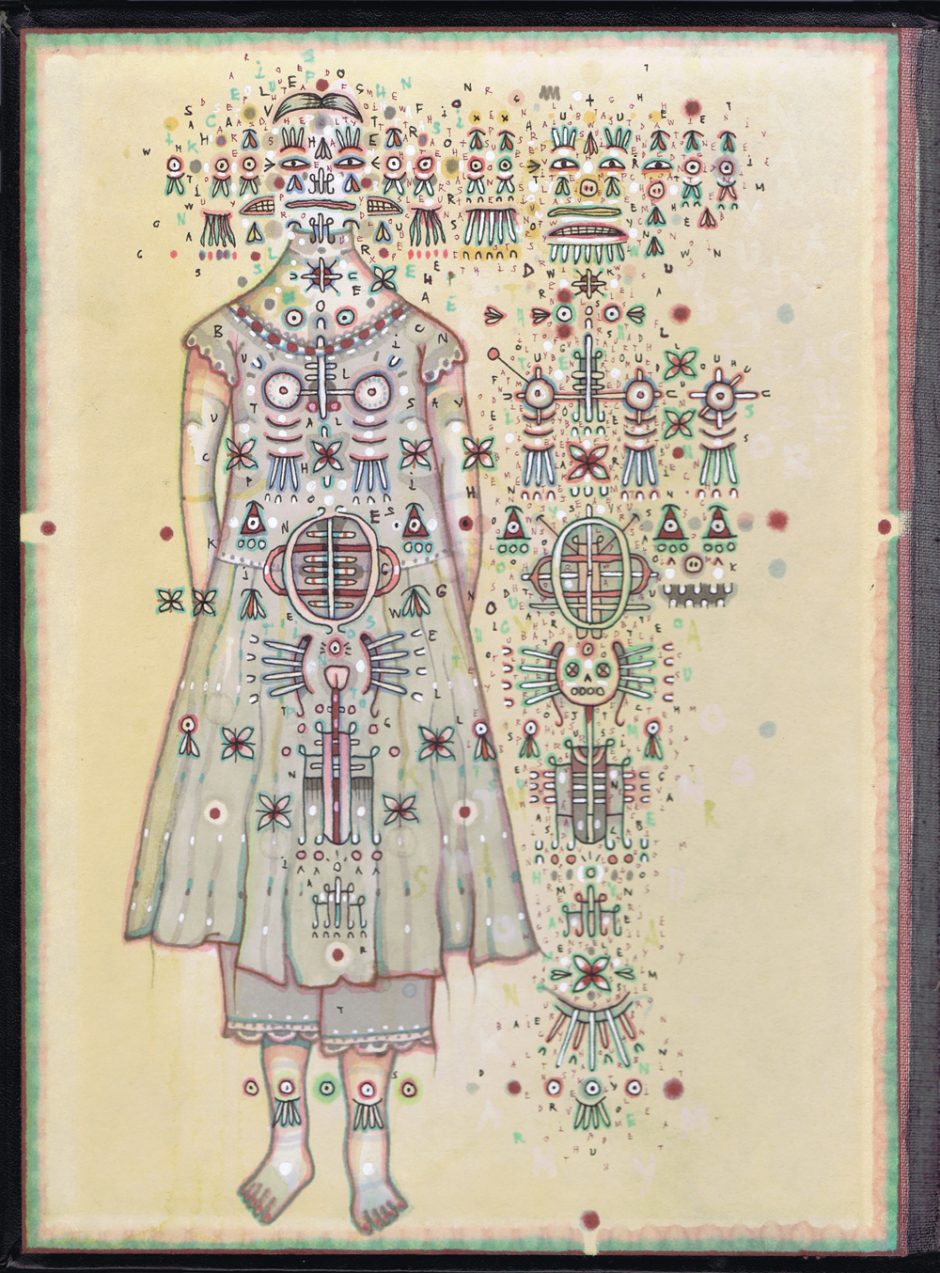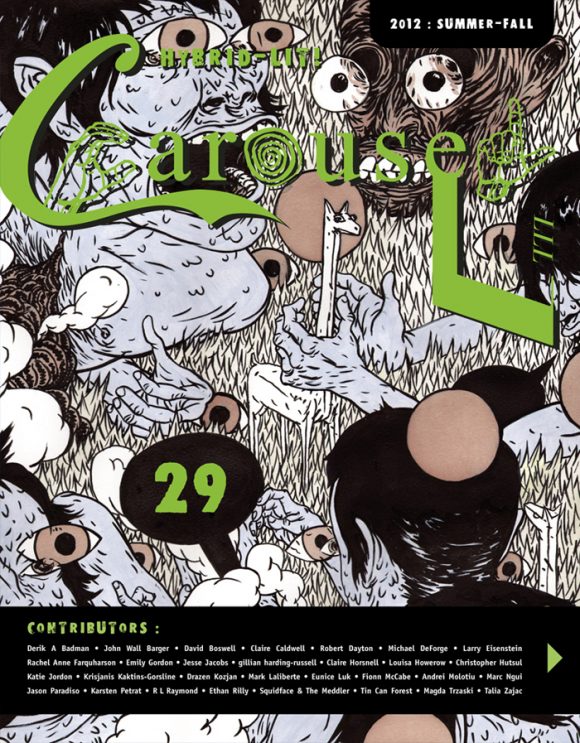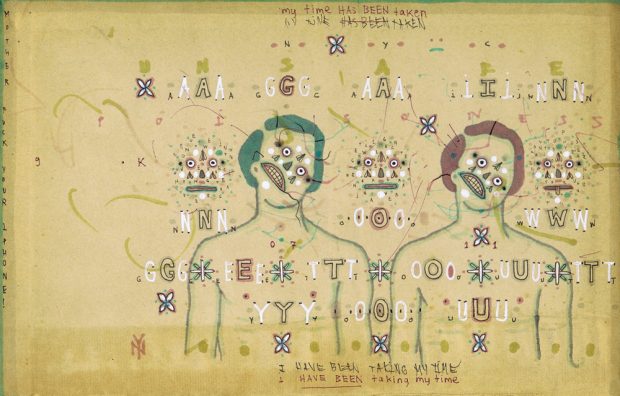From the Archive: Jeremiah Maddock (CAROUSEL 29)
Dislodged faces and code-like assemblies of letters litter the found book cover canvases of Jeremiah Maddock’s art works. The New York-based artist uses ink, bleach and marker to lend everyday, recycled materials a fine art aesthetic that has garnered him legitimate attention over the last few years. Maddock is flirting with books as art objects — perhaps unwittingly — carrying on a dialogue with the tradition of the artist book. He successfully gives paper ephemera an object status on the order of the sculptural, despite exhibiting his bodies of work in the context of wall mounted art.

This is what is so delightfully surprising about Maddock’s creations: each work, despite its diminutive size, has a veritable presence that lures viewers to it. Such is the case with a piece like Imp (2011): a tiny, double-headed creature with five languid legs and two extra feet stares outward, entranced. Adhered to an old portrait studio cardboard frame, the work is relic-like, imbued with the kind of sacredness inherent in collectable miniatures. It is not only the formal qualities that contribute to the atmosphere surrounding Imp, however. The frame still bears the original sitter’s name in cursive, a reminder that the small, alien deity whose “portrait” has been placed over the frame’s opening operates as a palimpsest. The history of images gets written and over-written as people, places and things are slotted into and replaced in time’s continuum. Furthermore, the visual vocabulary Maddock employs combines symbols and design motifs that seem ancient and futuristic at once. The inner framing element in Imp, for instance, has a gothic flare that counters the electrical circuitry running behind that figure’s legs and forming his facial features.
These anachronistic elements are a thread through many of Maddock’s recent pictures. Some Lady and Her Lies (2011), an image made up of a constellation of cyber-symbols, radiating prongs and interlocking loops, doubles back on itself as Aztec mask forms emerge from the fray. Behind the plasma surface upon which this multitude of shapes floats is a simply drawn female figure wearing an outdated frock and bloomers. Looking at this image, the viewer seeks answers to the kinds of questions instigated by the study of semiotics — why does the ovoid shape superimposed on the figure’s abdomen register in my brain as a uterus? From which inherited symbolic understanding did I learn to associate ankle adornment with pre-marital ceremony? The poly-flagellated shapes next to the woman’s head take on the appearance of earrings and perhaps a headdress, making it easy to imagine the person depicted as a First Nations princess or Aztec goddess. Maddock, therefore, sets up a Rorschachian platform from which his viewers are allowed to leap to their own conclusions.

Another prominent feature of the artist’s creations is the duplicitous nature of the characters he depicts. The works embody the two-way spectrum of good and evil, straddling the co-existence of sweetness and the potentially negative aspects of human agency. Candy Coated Bummer (2011) is a landscape-oriented piece painted on a book cover, the bottom edge of which remains abraded where its previous contents have been shorn away. Two economically drawn male torsos serve as substrates for frozen, teeth-baring visages. Although they each have candy coloured hair, the wide-eyed, dismal grimaces worn by the figures are unnerving. Compounding this sinister atmosphere is the forty-five degree rotation at which the features seem to be slipping out of place.
Above, between and across the chests of the twin catatonics are a smattering of letters, each bolded and echoed on either side by a ghostly, white duplicate. Assembled into words, the triplicated letters spell “My time has been taken AGAIN NOW GET OUT YOU I have been taking my time”, a foreboding message if ever there was one. Skeletal faces are suggested in the background as well, repeating the admonition laid out by the text and sealing the hybridized relationship in Candy Coated Bummer between image and word.

The objet-trouvé has been an important component of both DIY and fine art work for the last century. The different ways in which artists have employed these components has informed our understanding of materiality on both the micro and macro scale, proving that context can transform any object into something new and unrecognisable. In the case of Jeremiah Maddock, innovation is borne of his recognition of a found material’s naturally intriguing properties in addition to the manipulation of elements less obvious. The challenge to differentiate between the caustic effects of the artist’s application of bleach to paper and naturally degraded materials is tantamount to interacting with the artwork. The fact that each piece maintains both its bookishness and its ritualistic properties at a time when television and media are the new religion only reinforces the necessity for artists of Maddock’s variety. The artist produces an image that extends beyond intellectual understanding and descends to intuitive, guttural response. And that is an instinct that will last forever.

Portfolio: Jeremiah Maddock
appeared in CAROUSEL 29 (2012) — buy it here

